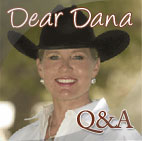Melissa Doddridge rides a Bentley to $10,000 HITS Hunter Derby win
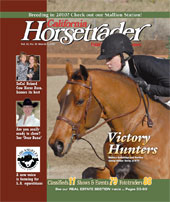 THERMAL — Melissa Doddridge delivered a one-two punch in the all-new $10,000 Devoucoux Hunter Derby when she captured both the blue and red ribbons in the two-round classic that highlighted the competition during Desert Circuit II at the HITS Desert Horse Park, in Thermal.
THERMAL — Melissa Doddridge delivered a one-two punch in the all-new $10,000 Devoucoux Hunter Derby when she captured both the blue and red ribbons in the two-round classic that highlighted the competition during Desert Circuit II at the HITS Desert Horse Park, in Thermal.
The Tustin teen-ager and her horse, Bentley, got the best of 41 starters on course designer John Manning’s first-round course, then she beat the 12 that came back to compete in the handy phase.
She catapulted to the top of the class after receiving five bonus points for brilliance and handiness, and posted a total score of 91 in the second round.
“The handy course was so much fun,” said Doddridge. “The most challenging part was finishing with eight strides away from the in-gate. My horses thought they were done, but the hardest part was yet to come!”
A rising voice gets heard
Los Angeles Horse Council is on the trail to preservation
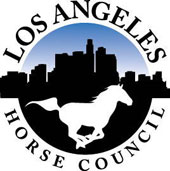 SHADOW HILLS – With the same spirit that has launched nations, a group of horsepeople in northeast Los Angeles has organized to get its due representation. And it’s working.
SHADOW HILLS – With the same spirit that has launched nations, a group of horsepeople in northeast Los Angeles has organized to get its due representation. And it’s working.
The agenda is an ambitious one:
- License all Los Angeles horses
- Educate city sanitation on horse manure as a resource
- Fix anomalies in city codes that deal with animal keeping
- Establish an equestrian “Bill Of Rights”
The nine-member board is just as ambitious, led by President Royan Herman, owner of Peacock Hill ranch and a self-described hot tempered Irishwoman who mixes hard work and passion into her heartfelt cause.
SCRCHA ‘buckles up’ 2009 with awards banquet
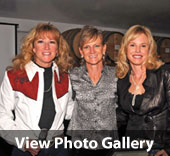 The Southern California Reined Cow Horse Association has grown to more than 400 member in 2010, but before the club launched into a new show season. it “buckled up” 2009 with an awards banquet at Stuart Cellars Vinceyard in Temecula on Feb. 20. Outgoing president Cindy Mendoza received special recognition, as new president Edwards takes the reins. The first event is March 12-13 at Casner Ranch, where the Green Oaks Pot O’ Gold Show, sponsored by Green Oaks Ranch, kicks of the season.
The Southern California Reined Cow Horse Association has grown to more than 400 member in 2010, but before the club launched into a new show season. it “buckled up” 2009 with an awards banquet at Stuart Cellars Vinceyard in Temecula on Feb. 20. Outgoing president Cindy Mendoza received special recognition, as new president Edwards takes the reins. The first event is March 12-13 at Casner Ranch, where the Green Oaks Pot O’ Gold Show, sponsored by Green Oaks Ranch, kicks of the season.
Establish ‘cuing zones’ for your legs
Specific zones for leg cues help refine communication
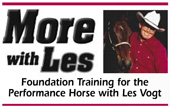 Next in a series
Next in a series
We continue our look at the fundamental riding skill of using your legs. In the last installment, we looked at forms of leg contact and also leg position.
If you’re going to be effective in controlling the horse’s body parts individually, you’re going to need to refine your cues as much as possible. One way that we do that is by having specific zones on the horse’s belly for your leg cues.
Extreme Cowboy Race — and clinic — are coming to Fillmore
Grand Otero Equestrian in Fillmore and the Extreme Cowboy Association (EXCA) are hosting their “Spring Fling” featuring Craig Cameron’s Extreme Cowboy Race in April. To help you prepare, they are hosting their first clinic prior to the event! Being held by EXCA National Champion, Cam Schryver, the clinic will focus on jumping, reining, roping, scary obstacles and course strategies. The clinic is being held March 20-21, so plan on registering early. The weekend will be packed with excitement, as well as a 50 percent payout, pot luck dinner and camp fire Saturday night for those interested. Bring your favorite dish, stories and instruments! See ad on page 85.
If lunging turns into tug-of-war, it’s time for a new approach – and gloves
HEY RAY!: Lunging is a large part of my training program. Most of my horses go around nice and easy, while some pull really hard. I give and take on the lunge line, but it mostly turns into a pulling contest that I lose. They listen and look good going around, but my hands hurt by the end of the lesson. Why do some horses pull and others don’t? How do I stop this tug of war?
–Wendy, Phelan, Calif.
HEY WENDY: I suggest you buy yourself a pair of gloves while you figure out your new approach. Like anything else with a horse, it’s all about the preparation that comes before that counts.
Sometimes learning to train a horse is a lot like experimenting with cooking. We sometimes end up with a delicious dish that we can’t duplicate because of the lack of a recipe. We end up with something we really like but we are not exactly sure how it happened. The dish we are about to prepare will now not only be simple to make but will be palatable for you and your horse.
The challenge here will not only be having your horse flex laterally without resistance but also being able to do it while moving forward through all the gaits with freedom. It doesn’t matter whether you use a lunging cavason or a halter. What is important, is that you use the kind of head gear that gives you leverage to make an impression if needed. Preparing the horse for lunging has nothing to do with lunging the horse. It’s easier to push the hind end away from you, than to pull the front end around you when trying to influence direction. When you are lunging, the horse is pulling on you. Pulling back only perpetuates the problem. Lunge the horse one or two feet away from you. The moment you feel resistance in your hand, push his hindquarters to the outside of the circle while resisting with your hands. When he makes the attempt to cross over and out with his hindquarters, his head will turn in toward you, releasing the pressure of the line in your hands. At that moment, feed him more line and drive him forward back on to the circle, but be careful not to unsettle him. That way he has a better chance of getting the picture you are trying to paint.
It’s all about getting that breakthrough. Continue this process every time you feel your horse leaning on your hands. This will teach him that looking toward you while slightly stepping out behind is more comfortable than leaning on the line. As he becomes more aware of the benefits of not leaning and pulling on the line, while walking or trotting closely around you, moving into a bigger circle should be part of the reward.
At the first signs of leaning, capture that pressure in your hand and — without losing it –simply reel him in slowly but consistently until he remembers the lesson. When he does, and he will, immediately put him back in a big circle. He will soon associate lightening up with big circles and big circles with being on the right track. This will become a self-rewarding system for your horse. Because bigger circles are easier to travel on than small ones, the horse will soon be motivated to do whatever is needed to be let out on to the big circle. Don’t attempt working at the canter with this exercise until the walk and trot are easy and clear for your horse.
Also, here is my answer your question, “Why do some horses pull and some don’t while lunging?”: A horse will do the right thing ( in this situation, not leaning) because you either intentionally taught him by explaining the value through an approach and/or system. The other reason a horse might do the right thing is because he simply figured it out on his own without your help. A situation presented itself with a challenge and the horse adjusted to it with the right answer simply by chance. When those things happen, we should feel lucky. The other way to feel lucky is to have a well thought-out system with a good approach and good, consistent practice. So, I hope you feel lucky in whatever you do.
Trust your instincts and think safe,
Ray
Horsetrader columnist Ray Ariss, husband to Pippa Ariss and father of six, shares his insight into the relationship of horseand human twice each month, in print and on www.horsetrader.com. He lives and trains in “Horsetown USA”, Norco, Calif., at his bustling Starbrite Riding Academy, where he currently has 50 horses in various stages of training, including Andalusians, Friesians, Quarter Horses, Paints, Thoroughbreds, Arabs, Mustangs and more. Ray attributes his training success to the support of his wife and partner, Pippa, and a system he calls S.W.A.P., to which he credits his multiple championships in several disciplines. His passionate understanding of the “human-horse” relationship was evident when he took on the challenge of training a wild Mustang and — in just 100 days — produced the highest-priced adopted Mustang ever — $50,000. Does your “horse-human relationship” leave you with a question for Ray? Click here to submit one!
First impressions: How you can improve your show ring presentation
You know the old saying “You never get a second chance to make a first impression!” When you and your horse enter the show ring you are speaking loudly without saying a word! You and your horse show that judge or those judges many things. Like, for example if you are ready for your class, if you are confident or nervous, or if you have paid attention to detail and if you are tuned up and ready to show.
I encourage you to become mindful, pay attention to the details that often make the difference between first place and fifth place. The judges only have a few moments to make their decision as to who will be their winners.
Find out what their judging standard is, what the rules are for your association, what the standard for your event is, what guidelines are they taught to judge by. Then honestly assess you and your horse. Where do you fit in your breed and event standard? The rules are constantly being revised so keep abreast of the rules you show with. Many trainers and riders get very caught up in their own opinion of what is good, but they miss the mark because the judges they show to are being trained and guided to judge a different standard. A great tool is to have someone video you riding, see yourself from the viewpoint of that person in the middle of the arena.
I am going to give you a checklist to make sure that when you enter the arena you give your best show ring presentation possible!
#1) Your Appearance
- Be clean and neat – most importantly be neat and orderly.
- Have your hat shaped and clean – pay a professional to clean and shape your hat. Most top horsemen and women take great pride in their hat. You can tell a lot by the shape of a person’s hat.
- Make sure your clothes are color coordinated and well matched.
- Make sure your saddle blanket is clean and neat and covers the pad that is underneath the blanket. Also make sure the color of the blanket compliments your outfit.
- Pin you numbers on straight and neat and make sure they are visible to the judge.
- Make sure your shirt is tucked in and pressed.
- I feel that women or girls should not wear blouses or shirts that are low cut or revealing. Remember, look professional and represent your breed and event well.
- Women or girls with long hair, make sure your hair is neatly put up in a ponytail or bun. If you have stray hairs hanging down, secure them with hairspray or pins.
- Make sure your saddle, bridle, and bit are clean and if you have any silver, make sure it is clean and polished.
#2) Your Horse’s Appearance
- Make sure your horse is clean and well groomed with no mud, dirt, or shavings anywhere visible on your horse.
- Clean your horse’s hooves – for large shows I hoof black or oil my horse’s feet.
- Mane, forelock, and tail should be brushed and tail clean to look full.
- Wipe the mouth and nostrils out and around the eyes.
- Fly spray your horse well so that he is not bothered by flies.
- Use polishing spray to add shine to your horse. (If your horse has a long hair coat, apply sparingly as this can make his coat look oily.)
- Make sure his tack is well fitted and know your association’s rules so that you are sure all of your equipment is legal.
#3) Your Ride
- Sit up tall and confident. Use good posture and horsemanship while riding, show you care. A rider who is slouched over will detract from the overall appearance of the horse. You want to compliment your horse, not to detract from him.
- Sit square, don’t twist your upper body or lean towards your rein hand.
- Be quiet with your hands.
- Look up and show your confidence. When you ride looking down at your horse you give the impression that something is about to go wrong and you need to fix it. Put your hand down, look up and show your horse.
- Keep breathing. Breathe deep through your diaphragm. This helps you to sit back and keep your seat where it belongs on your horse.
- Flow with your horse. Learn to get in rhythm with your horse’s gaits. Move with your horse’s movement, not against it. You will create a pleasing picture moving in sync with your horse.
#4) Your Attitude
- Your expressions, mannerisms, and body language tell the world your attitude. Your attitude often tells of your expectations and your expectations definitely determine your results. So…attitude is everything. Spend as much time on your attitude as you do on your horse’s grooming, picking your outfit, or even practicing your event.
- Show confidence, remember the saying “Fake it until you make it”. Everyone goes through periods when their confidence is low. You won’t move beyond that if you give in to fear or lack of confidence. Coach yourself, speak positively to yourself, encourage your self. You can do it too! Prepare as well as you can, because when you know you are ready, that builds confidence.
- Practice visualization – visualize in your mind the ride you want to have. Sports psychologists and coaches have proven visualization works – expect the best. Once you are in the arena you’ve done all you can do, so expect a great ride. We usually get what we expect.
- Be on time for your class. Be at the back gate ready when your class is called. Often the judges are watching the exhibitors as they are preparing to enter the arena. Let them see you acting positive and confident.
- Put a good expression on your face as you enter the arena, smile.
- Be courteous in the ring, don’t just think of yourself. Give other exhibitors room when passing.
- If a problem arises, handle it smoothly, and then go back to showing.
- Be a good sport whether you win or lose. Even the biggest winners have lost their share of classes. Gracefully accept your placing and remember it is just one person’s opinion.
Don’t take it too seriously or be too hard on yourself if you don’t have that perfect ride. There is always another day. But don’t give up, keep stretching to a new level. Raise your standard, and be the best you can be! Have a great ride!
DANA
Have your own question for Dana? If so, click here! If your question is used in “Dear Dana”, you will be entered into a monthly drawing for a FREE “Winning Strides” DVD!
Sign up for Dana’s newsletter and keep up with Dana’s updates, new products and clinic schedule! When you register, you are automatically entered into a quarterly raffle for great prizes, including a FREE personal training session with Dana! Click here to sign up now!


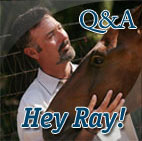
 Read Columns
Read Columns
